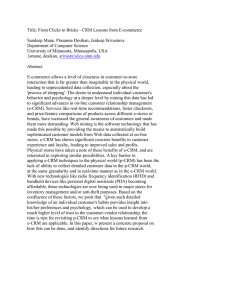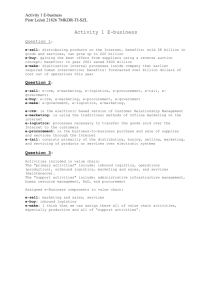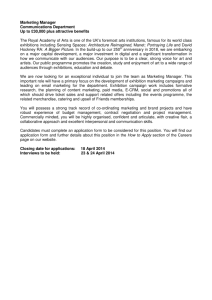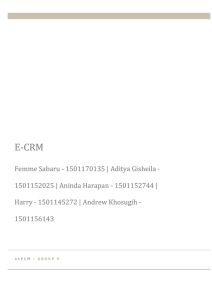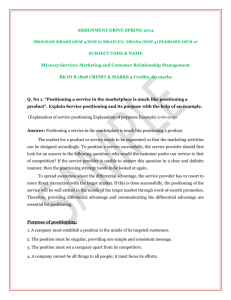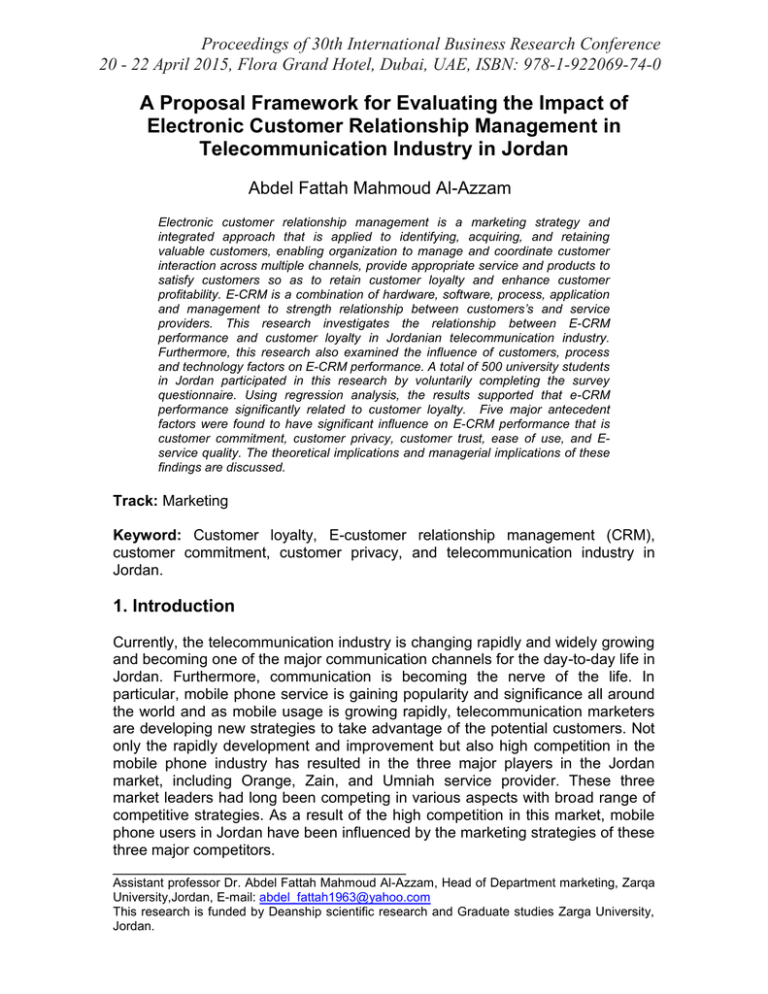
Proceedings of 30th International Business Research Conference
20 - 22 April 2015, Flora Grand Hotel, Dubai, UAE, ISBN: 978-1-922069-74-0
A Proposal Framework for Evaluating the Impact of
Electronic Customer Relationship Management in
Telecommunication Industry in Jordan
Abdel Fattah Mahmoud Al-Azzam
Electronic customer relationship management is a marketing strategy and
integrated approach that is applied to identifying, acquiring, and retaining
valuable customers, enabling organization to manage and coordinate customer
interaction across multiple channels, provide appropriate service and products to
satisfy customers so as to retain customer loyalty and enhance customer
profitability. E-CRM is a combination of hardware, software, process, application
and management to strength relationship between customers’s and service
providers. This research investigates the relationship between E-CRM
performance and customer loyalty in Jordanian telecommunication industry.
Furthermore, this research also examined the influence of customers, process
and technology factors on E-CRM performance. A total of 500 university students
in Jordan participated in this research by voluntarily completing the survey
questionnaire. Using regression analysis, the results supported that e-CRM
performance significantly related to customer loyalty. Five major antecedent
factors were found to have significant influence on E-CRM performance that is
customer commitment, customer privacy, customer trust, ease of use, and Eservice quality. The theoretical implications and managerial implications of these
findings are discussed.
Track: Marketing
Keyword: Customer loyalty, E-customer relationship management (CRM),
customer commitment, customer privacy, and telecommunication industry in
Jordan.
1. Introduction
Currently, the telecommunication industry is changing rapidly and widely growing
and becoming one of the major communication channels for the day-to-day life in
Jordan. Furthermore, communication is becoming the nerve of the life. In
particular, mobile phone service is gaining popularity and significance all around
the world and as mobile usage is growing rapidly, telecommunication marketers
are developing new strategies to take advantage of the potential customers. Not
only the rapidly development and improvement but also high competition in the
mobile phone industry has resulted in the three major players in the Jordan
market, including Orange, Zain, and Umniah service provider. These three
market leaders had long been competing in various aspects with broad range of
competitive strategies. As a result of the high competition in this market, mobile
phone users in Jordan have been influenced by the marketing strategies of these
three major competitors.
___________________________________
Assistant professor Dr. Abdel Fattah Mahmoud Al-Azzam, Head of Department marketing, Zarqa
University,Jordan, E-mail: abdel_fattah1963@yahoo.com
This research is funded by Deanship scientific research and Graduate studies Zarga University,
Jordan.
Proceedings of 30th International Business Research Conference
20 - 22 April 2015, Flora Grand Hotel, Dubai, UAE, ISBN: 978-1-922069-74-0
Thus, Companies including communication companies are putting much more
emphasis on customer relationship management (CRM) as a tool for managing
customer relationship and to increase customer satisfaction and loyalty. E-CRM
emerges from the internet and web technology to facilitate the implementation of
CRM. Therefore, by implementing e-CRM, they can provide services based on
customer need and expectations (Boohene, & Agyapong, 2011). However,
despite the importance of CRM to the success of the organization, empirical
studies on e-CRM performance particularly in the Jordanian context have been
less than encouraging. Furthermore, little systematic effort been taken to
understand the underlying consequences of e-CRM performance. Therefore, an
empirical study is needed to overcome this shortcoming. Finally, According to
Samsudin et al., (2010) there is lack of literature on E-CRM and more studies
work is needed in this area. This study will discuss the e- service quality, ease of
use, customer commitment, customer privacy, and customer trust as
antecedents of E-CRM performance in Jordan Mobile Phone Services by
reviewing the conceptual article and research findings.
2. Literature Review
A review of work in the area of e-CRM performance indicates that a little
research have investigated the antecedent of e-CRM performance. The previous
studies on the antecedent of e-CRM performance come from organization factors
such as, company policy, business process and strategies. As we understand,
the main objective of e-CRM activities is to create customer loyalty and customer
value. Based on the above discussions, there are several factors that may
influence e-CRM performance. It is clear that not all potential factors can be
included in the present study. Only those that are relevant with e-CRM
performance and mobile phone service from customer perspective were chosen.
2.1 Electronic Customer Relationship Management E-CRM
Electronic customer relationship management (e-CRM) is a new phenomenon
within an electronic commerce (marketing) that has increased its importance
dramatically over the last few years, and will continue to do in the future. E-CRM
exists to replace the traditional 'four Ps' of marketing (product, price, place and
promotion) (Nor Azila & Mohd Noor, 2011). Furthermore, a number of studies
suggested that the 4Ps of marketing mix is no longer the dominant marketing
logic and that relationship marketing may be a more appropriate new paradigm
for marketing thought, theory and practice (Gura, 2003; Nor Azila & Mohd Noor,
2011).Therefore, e-CRM is designed for people at all levels in business who
wants to develop relationships with customers electronically. Because of that, it is
critical to understand the important role that e-CRM plays within modern
marketing organizations (Usman,Jalal, & Musa, 2012). Currently, the primary
focus of study has centered on the impact of e-CRM performance from
customers and organizational perspective. Studies discovered numerous positive
outcomes of e-CRM performance such as customer satisfaction (Khalifa,& Shen,
2005; Usman, et al., 2012), purchase intentions (Khalifa,& Shen, 2005, Wang et
al., 2004), customer retention [Jayachandran et al., 2005), knowledge
management (Donio et al., 2006), profitability (Kim et al., 2004), relationship
Proceedings of 30th International Business Research Conference
20 - 22 April 2015, Flora Grand Hotel, Dubai, UAE, ISBN: 978-1-922069-74-0
development (Rabbai, 2012), organizational commitment (Keshvari, 2011; Hamid
et al., 2011) and customer loyalty (Khaligh et al., 2012; Chang et al., 2005).
2.2 Customer Commitment
One of the most important factors to influence e-CRM performance is customer
commitment. This variable is considered in marketing literature as a significant
factor necessary for the creation, building and maintenance of relationship (Al
momani, & Norazila, 2009).The notion of customer commitment has been
introduced and used widely in marketing and organizational environment. For
instance, Aydin, and Ozer (2005) considered behavioral commitment as a critical
variable to differentiate social from economic exchange. But little is known about
the potential role of commitment in e-commerce and hence e-CRM performance
(Dimitrioder, 2006). Despite the fact that commitment is a central construct in the
area of relationship marketing, there is little agreement on the nature of this
construct. Customer commitment is defined as a desire to maintain a relationship
with service provider (Nor Azila & Mohd Noor , 2011). Lee, (2003), defined
commitment as a psychological state generated by an individual’s perception,
beliefs and emotions which aggravate the willingness or intention of developing
and maintaining a stable relationship. The various definitions make it difficult to
determine what commitment means to customers and organization. Furthermore,
the successful relationship marketing requires relationship commitment between
buyers and seller. Therefore, commitment is central to all the relational
exchanges between the customer and service providers. Furthermore, the
present study hypothesizes that customer commitment influences significantly eCRM. This is because some prior studies demonstrate significant results in this
regard. Hence, based on the above arguments, the following hypothesis is
offered.
Hypothesis 1: There is a significant positive relationship between customer
commitment and e-CRM.
2.3 Customer Privacy
Another customer factor that has been chosen as antecedent variable in the
present research is customer privacy. Privacy is a difficult concept to describe
and define since privacy has been used to demonstrate a wide number of
interests including personal information control, reproductive autonomy, access
to places and bodies, secrecy, and personal development (Samsudin, et al,
2011). Furthermore, there are numerous definitions and measures of privacy, but
there is no consensus on a single definition. Samsudin Wahab et al., (2011),
defined privacy as the right of an individual to control the information held about
them by third parties. Furthermore, privacy can be also defined as the people
right to be secure in their persons, houses, papers, and effects against
unreasonable searches and seizures, shall not be violated, and no warrants shall
issue, but upon probable cause, supported by oath or affirmation, and particularly
describing the place to be searched, and the persons or things to be seized
(Rabba, 2012). Besides, AlShaali & Varshney (2005), identified privacy as a key
issue that internet marketers need to recognize and address. Finally, it is clearly
that information security and privacy is the most critical problem faces the
Proceedings of 30th International Business Research Conference
20 - 22 April 2015, Flora Grand Hotel, Dubai, UAE, ISBN: 978-1-922069-74-0
dealers over the Internet. Study by Casalo, et al., (2008), explore that the
customers have very strong views about protecting their privacy on the internet.
Based on the above literature we notice that privacy is a significant CRM
concern, and it is clear that privacy is very important factor influencing ebusinesses and e- commerce. Hence, based on the above arguments, the
following hypothesis is offered.
Hypothesis 2: There is a significant positive relationship between customer
privacy and e-CRM.
2.4 Customer Trust
Trust also appears to be an important antecedent to e-CRM. Taylor, & Hunter,
(2003), defines trust as the expectation that arises within a community of regular,
honest, and cooperative behavior, based on commonly shared norms, on the
part of members of that community. Taylor, & Hunter, argues that the
technological revaluation will make trust ever more important in understanding
business behaviors (like marketing). Trust has been defined as users’ thoughts,
feeling, emotion, or behaviors that occur when customers feel that the provider
can be relied upon to act in their best interest when they give up direct control
(Mukherjee, & Nath ,2007). Moreover, trust is important in the online
environment, affecting customer’s perception and willingness to participate and
establish relationships with suppliers’ online (Aniba, 2011; Samsudin Wahab ,
2011). Moreover, Al-Momani (2009), found a positive relationship between the
level of trust in the technology and customer intention to adopt e-commerce.
Most researchers agree that lack of trust is a critical issue that needs addressing
regarding to the internet and e-CRM adoption. Lai et al., (2010), argue that lack
of trust has been one of the most significant reasons for customer not adopting
online services. Recently, there have been a number of empirical studies
investigating the role of trust in the specific context of ecommerce. As a
summary, trust is an important factor in customer attitude toward e-service and ecommerce (e-CRM). This study proposes trust as one of the antecedents for eCRM performance. Hence, based on the above arguments, the following
hypothesis is offered.
Hypothesis 3: There is a significant positive relationship between trust and eCRM
2.5 Ease of Use
Ease of use is another technology factor influence e-CRM performance.
According to Davis (1989), ease of use is the degree which a person believes
that using a particular system will be free of effort. It has a strong influence on
behavioral intention to adopt technology. If a technology is perceived as too
difficult to use, a person will choose an alternative option that is easier for him or
her to perform. It is one of the “classical” concepts in information systems
research (Davis 1989; Sanders & Manrodt, 2003). In addition, perceive ease of
use has been established in previous studies to influence customer intention and
behavior, either directly or indirectly via perceived usefulness. However, some
studies have linked perceive ease of use to the success and quality of
Proceedings of 30th International Business Research Conference
20 - 22 April 2015, Flora Grand Hotel, Dubai, UAE, ISBN: 978-1-922069-74-0
information system ( Kem, & Forsyth, 2010) as well as to customer satisfaction (
Lola, 2011). According to the previous studies on the TAM, perceived ease of
use is found to have direct effect on behavioral intention (Davis, 1989). Finally,
when mobile phone users perceive ease of use, they can convenient access to
all varieties of business communication and services by the mobile phone
anywhere and anytime then can easily and quickly schedule meeting and
activities with their colleagues and get much faster search capability. In
conclusion, it can be concluded that ease of use is one of the technology factor
that plays significant role in e-CRM performance. Hence based on the
arguments, the following hypothesis is proposed.
Hypothesis 4: There is a significant positive relationship between ease of use
and e-CRM.
2.6 E-Service Quality
Beside the previous factors chosen as antecedent of e-CRM performance, eservice quality is one of the components in the process factor that has been
found related to e-CRM performance. Generally, service quality is an important
factor for profitability, and thereby service providers’ success. There are two
fundamental processes that explain the contribution of electronic service quality
to profitability for customers and service providers. Firstly, service quality is
considered as one of the few means for service differentiation and competitive
advantage that attracts new customers and contributes to the market share.
Secondly, service quality enhance customers’ tendency to use the service more,
to use more services, to become less price-sensitive and to tell other friends
about favorable and useful service provided ( Al-Momani, & Noor, 2009).
However, numerous previous studies have found a significant relationship
between e-service quality and behavioral intention (Wu &Lin, 2007; Hackman
etal., 2006). Perceived service quality is an overall judgment of a service that
contributes to customer satisfaction, purchased intentions, and firm performance
(Al-Momani, & Noor, 2009; Cronin & Taylor, 1992;). Many studies have been
conducted to investigate the influence of service quality on customer satisfaction.
The significance of service quality as an antecedent of customer satisfaction and
eventually customer loyalty has been approved (Wal et al.,2002; Zeithaml &
Malhorta, 2002). However, this research attempts to address this gap by
examining electronic service quality as one of e-CRM performance antecedent to
explain behavior intention in mobile phone service context. Evidently, based on
the earlier discussion, it is clear that e-service quality is a very important factor in
influencing customer attitude toward e-service. Hence based on the arguments,
the following hypothesis is proposed.
Hypothesis 5: There is a significant positive relationship between E-service
quality and e-CRM.
2.7 Customer Loyalty
Recently, competitive and changeable market place and customer loyalty are
seen to be critical factors to the success of business firms because attracting
new customers is more expensive than retaining exiting ones (Lee, et al., 2003;
Rabbai, 2012). Numerous studies have suggested that loyal customers are a
Proceedings of 30th International Business Research Conference
20 - 22 April 2015, Flora Grand Hotel, Dubai, UAE, ISBN: 978-1-922069-74-0
competitive asset and that a way to retain customers is through secure and
collaborative relationship between customers and service providers (Ismail,
2009). Customer loyalty has defined in numerous different but similar ways by
different researchers. Khan, and Khawajo (2013) treat customer loyalty in
behavioral term like repeat purchasing frequency or relative volume of samebrand purchasing. Oliver (1997) defines customer loyalty as “a deeply held
commitment to re-buy or re-patronize a preferred product/service consistently in
the future” (p.34). According to Gummeras et al., (2004), loyal customers are
defined as those customers who hold favorable attitude toward a product,
recommend the product to other customers and exhibit repurchase behavior.
Furthermore, in this study, customer loyalty was chosen as the main
consequence of e-CRM performance as the previous literatures support the
relationship between them. However, this change shifts competition in mobile
phone service sector in Jordan from core service to value-added service.
Therefore, the service providers should differentiate their services and guarantee
quality of their service in order to maintain their market share and to enhance
their customer satisfaction and loyalty.
2.8 Theoretical Framework
This study primary focuses on exploring the antecedent of e-CRM performance
and its impact on customer loyalty. Based on the literature review and research
problems, we develop an integrative framework that is demonstrated in Figure1.
Furthermore, the framework of the present study addresses independent
variables that include customer commitment, customer privacy, customer trust,
ease of use, E-service quality. The framework also considers e-CRM as a
mediating variable and customer loyalty as a dependent variable. Therefore, the
proposed model that incorporates the variables to be studied is illustrated in
Figure 1
Customer commitment
Customer privacy
E-CRM
Customer trust
Customer loyalty
Ease of use
E-service quality
3. Methodology
3.1 Population and Sample
The study’s target population consisted of mobile phone users in Jordan. This
study sample was students studying in Jordan University. A stratified sampling
Proceedings of 30th International Business Research Conference
20 - 22 April 2015, Flora Grand Hotel, Dubai, UAE, ISBN: 978-1-922069-74-0
was used to select approximately equal numbers of customers from each
university. Questionnaires distributed to five universities in the southern,
northern, and central states of Jordan. Furthermore, students were selected
because the student population is known for its technological expertise (Hair et.,
2007; Coakes et al., 2006). In addition, there were 500 questionnaires distributed
to five universities in Jordan, in Arabic languages. However, only 450 were
completed as usable questionnaires and were used for data analysis in this
research. According to Sekaran (2006), 450 responses are considered as an
acceptable number for researchers to proceed with data analysis.
3.2 Data Collection Procedures
Data were collected by Self-administered questionnaires from Jordan university
students in Jordan. Once the entire respondents have been identified, the next
procedure in the study involved distribution of the questionnaires. Data were
collected through survey whereby the questionnaires were distributed to the
respondents personally by hand. Furthermore, all respondent were given two
weeks to complete the questionnaires and were asked to submit the completed
ones to the researcher by hand. Majority of the questionnaires (450) were
collected immediately on the same day of distribution or after the given time (two
weeks).
3.2 Data Analysis
Data analysis involved steps such as coding the responses, cleaning, screening
the data and selecting the appropriate data analysis strategy (Churchill &
Lacobucci, 2004; Sekaran, 2000). For the purpose of data analysis and
hypotheses testing, several statistical tools and methods were employed from
SPSS software version 15. This includes factor and reliability analysis to test the
goodness of the measures, descriptive statistics to describe the characteristic of
respondents, and to compare the extent of e-CRM performance performed by the
respondents between different demographic profiles. Correlation analysis is used
to describe the relation between the variable and regression analysis is utilized to
test the influence e-CRM performance on customer loyalty, and the influence of
antecedent factors on e-CRM performance.
4. Results and Discussion
4.1 Descriptive Analysis
Subsequent to the assessment of normality is descriptive statistics analysis.
Descriptive statistics include the minimum and maximum, means, standard
deviation and variance for the interval-scaled variables. The researcher
depended on the data from the questionnaire to determine the level of e-CRM
performance and customer loyalty perceived by subscribers in mobile phone
service in Jordan. As shown in Table 1, the mean values for most of the variables
are at the range of 3.82 to 3.97. This indicates that most respondents share
slightly similar opinions on customer factors, technology factors, and process
Proceedings of 30th International Business Research Conference
20 - 22 April 2015, Flora Grand Hotel, Dubai, UAE, ISBN: 978-1-922069-74-0
factor and customer loyalty. Most of the standard deviation were less than 1.00,
indicating that the variation on respondents’ opinions were small.
Table 1: Descriptive Statistics of Main Variables (n = 450)
Variables
ECRM
Customer loyalty
Customer commitment
Customer privacy
Customer trust
Ease of use
E-service quality
Total items
6
6
6
6
6
6
6
Min
1.00
1.00
1.00
1.00
1.00
1.00
1.00
Max
5.00
5.00
5.00
5.00
5.00
5.00
5.00
Mean
3.9645
3.8439
3.8448
3.9718
3.94571
3.8292
3.9473
Std. deviation
. 46265
.61878
.56692
.65252
.48037
.62278
.508870
4.2 Scale Reliabilities
Cronbach’s alpha can be considered as a perfectly adequate indication of the
internal consistency, and thus of reliability (Sekaran, 2007). It is the most widely
used indicator. The generally agreed upon most acceptable value for Cronbach’s
alpha is 0 .70, although it may decrease to 0.50 in exploratory research (Hair et
al., 2007). Table 2 below summarizes the reliability test of the measures after
taking in to the consideration of deleted items. As demonstrate, the Cronbach’s
alphas of the measures were all above the lower limit of acceptability that is more
than 0.50. For this reason, all measures were highly reliable and acceptable, and
thus, providing strong support for the variable components.
Table 2: Reliability Analysis
Factors
Customer loyalty
E-CRM performance
Customer commitment
Customer privacy
Customer trust
Ease of use
E-service quality
Number of items
8
6
6
6
6
6
6
Cronbach’s Alpha
.865
.827
.803
.790
.752
.730
.700
4.3 Correlation Analysis
Table 3 shows a summary of the results from correlation analysis. The
computation of the Pearson correlation coefficient was performed to understand
the relationship among all variables in the study. The correlation coefficients (r)
given in Table 3 indicate the strength of the relationship between the variables
and the correlation coefficient for all latent variables were found under the
threshold of .90 (Hair et al., 2006). Overall correlation values of the variable as
shown in Table 3 showed correlation coefficients with values above .5, which
normally indicate high associations between variables. With regard to the
relationship between e-CRM performance and customer loyalty, the correlation is
highly significant at .67. Cohen (1988) suggests that if r score is above .50 the
correlation between the two variables are considered largely correlated. It gives
indication that e-CRM performance is one of the variables influencing customer
loyalty. On the other hand, majority of the antecedents are significantly correlated
Proceedings of 30th International Business Research Conference
20 - 22 April 2015, Flora Grand Hotel, Dubai, UAE, ISBN: 978-1-922069-74-0
with e-CRM performance with values above .5. According to Cohen (1988) and
Pallant (2007), a coefficient of more than .50 means largely correlated variables.
Table: 3 Pearson Correlations of Study Variables
ECRM COM
CPRV TRST EOUS ESQ
ECRM 1.0
COM
.82 (**)
1.0
CPRV
.65 (**)
.64(**)
1.0
TRST
.77 (**)
. 56(**)
.66(**)
1.0
EOUS
.79 (**)
.56(**)
.61(**)
53(**)
1.0
ESQ
.855(**) .52(**)
.50(**)
.50(**)
.61(**)
1.0
** Correlation is significant at the 0.01 level (2-tailed).
* Correlation is significant at the 0.05 level (2-tailed).
Note: Electronic customer relationship management performance= ECRM,
customer commitment=CRM, customer privacy=CPRV, customer trust=TRST,
Ease of use=EOUS, electronic service quality=ESQ
4.4 Regression Analysis
To determine the effect of customer commitment, customer privacy, customer
trust, Ease of use, and electronic service quality, on E-CRM performance?”
regression analysis was undertaken on the antecedent factors and E-CRM
performance. The major assumptions take in our consideration are sample size,
Multicollinearity and singularity, Outliers, Normality, linearity, homoscedasticity.
All these assumptions have been tested to make this data suitable for regression
analysis. Multiple regressions are used to explain the relationship between a
single dependent (criterion) variable and several independent (predictor)
variables. There are a few approaches that are used for multiple regression
analysis such as standard regression, hierarchical or sequential, and stepwise
regression (Palant, 2001; 2007).
Table: 4. Summary of Multiple Regressions Analysis for Factors Influencing
e-CRM Performance
Model
Independent variable
B
Beta
Sig
0.261
0.199
0.000
customer commitment
0.332
0.326
0.000
customer privacy
0.254
.049
0.000
customer trust
0.335
0.293
0.000
Ease of use
0.183
0.122
0.002
electronic service quality
Note; DV= e-CRM; R = .863
Adjusted R Square = .744
R Square = .744
Proceedings of 30th International Business Research Conference
20 - 22 April 2015, Flora Grand Hotel, Dubai, UAE, ISBN: 978-1-922069-74-0
Table: 5.The influence of ECRM Performance on Customer loyalty.
Model
Unstandardized
coefficient
B
Std.
error
-.462
.120
.443
.039
Standardized
coefficient
Beta
(Constant)
ECRM
.393
R = .862
Adjusted R Square = .741
R Square = .743
df = 4
F statistics = 385.300
Sig = 0.00.
Note. Dependent variable: customer loyalty
Collinearity
statistics
t
Sig.
-3.859
11.290
.000
.000
.398
2.510
4.5 Hypothesis Test
The results of Hypotheses 1 demonstrates that customer commitment is
significantly and positively related to ECRM for the total sample (β= 0.261,
p=.000). Therefore, the results support Hypothesis 1. Regarding Hypotheses 2,
the data indicate that customer privacy is significantly related to ECRM for the
total sample (β=. 0.332, p=.000). Therefore, the results support Hypothesis 2.
The findings of Hypotheses 3 indicate that customer trust is significantly and
positively related to ECRM for the total sample (β= 0.254, p=.000). Therefore, the
results support Hypothesis 3. Also, the findings of Hypotheses 4, the data
indicate that Ease of use is significantly related to ECRM for the total sample (β=
0.335, p=.000). Therefore, Hypothesis 4 is support. Furthermore, the findings of
Hypotheses 5 indicate that electronic service quality is significantly and positively
related to ECRM for the total sample (β= 0.183, p=0.002). Finally, the findings of
Hypotheses 6 indicate that ECRM is significantly and positively related to
customer loyalty for the total sample (β= .443, p=0.000)
5. Conclusions
This research proved that there are five factors that have a significant
relationship with E-CRM performance; these factors are customer commitment,
customer privacy, customer trust, ease of use, electronic service quality. The
possible reason is that University students have numerous services to enjoy
more than mobile phone service, such as, sports, computer, internet services,
and libraries ….etc. Therefore, students use the mobile phone for other
objectives as making and receiving calls, SMS service, discussing studying
issues but not for enjoyment. Also, most of the students use old types of mobile
phone and this mobile phone have no facilities for internet serving. The findings
of this research give numerous implications for mobile service providers and
marketing managers with regard to how to plan and market services that will be
considered valuable by customers and used in the future. Additionally, the
present research regarded as important grounds for formulating and
implementing e-CRM performance in evaluating service providers to assign
proportionate amount of resources to achieve sustainable customer loyalty.
Regarding the variables that influencing E-CRM performance. The present study
suggests numerous variables as important determinants of E-CRM performance.
Proceedings of 30th International Business Research Conference
20 - 22 April 2015, Flora Grand Hotel, Dubai, UAE, ISBN: 978-1-922069-74-0
Mobile phone service providers should strive to improve E-CRM performance in
their efforts to attain higher level of customer loyalty. Finally, we believe that the
current research provides beneficial implications for both academic research and
practitioners based on an insightful review of the existing work on some of the
antecedents of E-CRM performance. References
6. Reference
Ackfeld , A., & Coole, L. (2003). A study of organization citizenship behavior in a
retail setting (electronic version). Journal of business research, 58 (2),
151-159
Al-Momani, K. & Noor, A. (2009). E-service quality, ease of use, usability and
enjoyment as antecedents of e-CRM performance: an empirical
investigation in Jordan mobile phone services. The Asian Journal of
Technology Management, 2(2), 11-25.
Avlonitis G, Panagopoulos N (2005). Antecedents and Consequences of CRM
Technology Acceptance in the Sales Force. Ind. Mark. Manage., 34: 355368.
Aydin and G. Ozer, “The Analysis of Antecedents of Customer Loyalty in the
Turkish Mobile Telecommunication Market,” European Journal of
Marketing, vol. 39(7/8), 2005, pp. 910-925.
Boohene, R. & Agyapong, G.K.Q. 2011. Analysis of the Antecedents of
Customer Loyalty of Telecommunication Industry in Ghana: the Case of
Vodafone (Ghana). Canadian Center of Science and Education
Burns, A., & Bursh, R. (2002). Marketing research: on line research applications
(4th e d). New Jersey: Prentice Hall
Chang, T, Liao , L, &. Hsiao, W, (2005) “An Empirical Study on the e-CRM
Performance Influence Model for Service Sectors in Taiwan,”Proc. IEEE
International Conference on e-Technology, e-Commerce and e-Service,
IEEE Press, March 2005, pp. 240-245.
Chen, I.J. and K. Popovich, 2003. Understanding customer relationship
management, CRM people process and technology, Business Process
Management Journal, 9(5): 672-88
Churchill, G., and Iacobucci, D. (2004). Marketing Research: Methodological
Foundations, 9th ed, Thomson South-Western, Ohio.
Cronin, J.J. and Taylor, S.A. (1992). Measuring service quality: a reexamination
and extension. Journal of Marketing Research, 56, 55-68.
Coakes, S., Steed, L., & Dzidic, P. (2006). SPSS version 13.0 for windows
Milton: John Wiley and sons Australia
Cohen, J. (1988). Statistical power analysis for the behavioral science (2nd ed).
Mahwah. NJ: Lawrence Erlbaum Associates
Davis, F. (989). Perceived usefulness, perceived ease of use, and user
acceptance of information technology. MIS Quarterly, 13(3), pp. 319-40
Donio’, J, Massari, P and G. Passiante, G, (2006) “Customer Satisfaction and
Loyalty in a Digital Environment: An Empirical Test,”Journal of Consumer
Marketing, vol. 23(7), , pp.445-457.
Proceedings of 30th International Business Research Conference
20 - 22 April 2015, Flora Grand Hotel, Dubai, UAE, ISBN: 978-1-922069-74-0
Gummerus, J., Liljander, v., P, M., & Riel, A. v. (2004). Customer loyalty to
content-basedWeb sites: the case of an online health-care service.
Journal of Services Marketing, 18(3), 175-186.
Garland, R. (1991). The mid-point on rating scale: is it desirable? Marketing
Bulletin, 2, 66-70.
Gura˘u, C (2003), “Tailoring e-Service Quality through CRM,” Managing Service
Quality, vol. 13(6), , pp. 520-531.
Hackman, D., Gundergan, S. P., Wang, P. and Daniel, K. (2006). A service
perspective on modelling intentions of on-line purchasing Journal of
Service Marketing, 20(7), 459-470.
Hair, J, Money, A., Samouel, F., & Page, M, (2007). Research method of
business. London John Wiley and Sonsltd, Chichester
Hair, J., Black, B., Babin, B., Anderson, R., & Tatham, R. (2006). Multivariate
data analysis: Upper saddle river, NJ: Pearson prentice hall.
Hamid, Noor; Cheng, Aw Yoke and Akhir, Romiza, (2011) “Dimensions of ECRM: An Empirical Study on Hotels’ Web Sites”, Journal of Southeast
Asian Research, Vol. 2 No.11, pp.1-15.
Jayachandran, S. Sharma, P. Kaufman &. Raman, P, (2005) “The Role of
Relational Information Processes and Technology Use in Customer
Relationship Management,” Journal of Marketing,vol. 69, pp. 177-192.
Jones, M., Mothersbaugh, D. and Beatty, S. (2002). Why customers stay:
Measuring the underlying dimensions of service switching costs and
managing their differential strategic outcomes. Journal of Business
Research, 55, 441–450.
Khalifa, M, & Shen, N, (2005), “Effects of Electronic Customer Relationship
Management on Customer Satisfaction: A Temporal Model,” Proc. 38th
Annual Hawaii International Conference on System Sciences, 3 (4), pp.
171-178.
Kim,J, & Forsythe, F.(2010)."Factors affecting adoption of product virtualization
technology for online consumer electronics shopping", International
Journal of Retail & Distribution Management, 38 (3),pp. 190 – 20.
Khaligh, Alireza ; Miremadi, Alireza & Aminilari, Mansoor, (2012) “The Impact of
eCRM on Loyalty and Retention of Customers in Iranian
Telecommunication Sector”, International Journal of Business and
Management, Vol. 7, No. 2, pp.150-162
Kim, J, Choi, J,. Qualls, W, & Park, J (2004)“The Impact of CRM on Firm and
Relationship
Level
Performance
in
Distribution
Networks,”
Communications of the Association for Information Systems, vol. 14, pp.
632-652.
Lai, I. K. W., Tong, V. W. L. and Lai, D. C. F. (2010). Trust factors influencing the
adoption of internetbased interorganizational systems. Electronic
commerce research & applications, 1-9 L.
Lee-Kelley, D. Gilbert & R. Mannicom, (2003), “How e-CRM Can Enhance
Customer Loyalty?,” Marketing Intelligence & Planning, vol. 21(4/5), 2003,
pp. 239-248.
Proceedings of 30th International Business Research Conference
20 - 22 April 2015, Flora Grand Hotel, Dubai, UAE, ISBN: 978-1-922069-74-0
Lola,N.(2011). Factors Influencing Consumer Bidding Behavior in Online Auction
(Consumer-to-Consumer. published doctoral theses, Lynn University
Mukherjee, A. & P. Nath (2007). "Role of electronic trust in online retailing A reexamination of th commitment-trust theory." European Journal of
Marketing 41(9/10): 1173-1202
NorAzila & Mohd Noor (2011), Electronic Customer Relationship Management
Performance: Its Impact on Loyalty From Customers’Perspectives.
International Journal of e-Education, e-Business, e-Management and eLearning, Vol. 1, No. 1, April 2011
Rabbai, R, (2012), Investigating the Impact of E-CRM on Customer Loyalty: A
Case of B2B in Zain Company in Jordan. Publish Thesis, Middle East
University.
Samsudin Wahab (2011), The Antecedents of Electronic Customer Relationship
Management Performance (e-CRM) in Electronic Services. International
Conference on Computer Engineering and Applications
Sekaran, U. (2007). Research methods for business: A skill-building approach
(4th ed). New Delhi: John Wiley and sons.
Sekaran, U. (2006). Research methods for business: a skill building approach
New Delhi: Wiley India.
Samsudin Wahab1, Kamaruzaman Jusoff2*, Khaled Abed Mufleh Al Momani3,
Nor Azila Mohd Noor3 and Ahmad Suffian Mohd Zahari1 (2011), The
influence of usability and enjoyment on electronic customer relationship
management performance inJordan mobile communication services.
Africa Journal of Business Management Vol. 5(1), pp. 128-134, 4 January,
2011
Sanders, N. R. and Manrodt, K. B. (2003). Forecasting software in practice: Use,
satisfaction, and performance. Interfaces, 33(5), 90-93.
Samsudin, W, Kaled, A, & Norazila, (2010), The Relationship between E- Service
Quality and Ease of Use On Customer Relationship Management (CRM)
Performance: An Empirical Investigation In Jordan Mobile Phone Services
Keshvari, Rozita, (2011), “The Impact of E-CRM on Customers Attitude and Its
Association with Generating Competitive Advantages in Iranian Financial
B2B Context”, International Business Research, Vol. 5 No. 4, pp.34-54.
Usman, U, Jalal, A & Musa, M, (2012), The impact of electronic customer
relationship management on consumer’s behavior. International Journal of
Advances in Engineering & Technology, 3(1), pp 500- 504.
Vuuren, T, Lombard,M, & Tonder, E, (2012), Customer satisfaction, trust and
commitment as predictors of customer loyalty within an optometric
practice environment. Southern African Business Review Volume 16
Number 3 2012
Wang, Y., Lo, H. P., Chi, R., & Yang, Y. (2004). An integrated framework for
customer value and customer relationship management performance: a
customer-based perspective from China. Managing Service Quality,
14(2/3), 169-182.
Wal, R. W. E. V. d., Pampallis, A. and Bond, G. (2002). Service quality in a
cellular telecommunications company: a South African experience.
Managing Service Quality, 12(5), 323-335.
Wu, J. and Liu, D. (2007). The effects of trust and enjoyment on intention to play
online games. Journal of Electronic Commerce Research, 8(2), 128-140.
Proceedings of 30th International Business Research Conference
20 - 22 April 2015, Flora Grand Hotel, Dubai, UAE, ISBN: 978-1-922069-74-0
Zeithaml, V., Parasuraman, A. and Malhorta, A. (2002). Service quality delivery
through web sites: a critical review of extant knowledge. Journal of the
Academy of Marketing Science, 30(4), 362-375.

